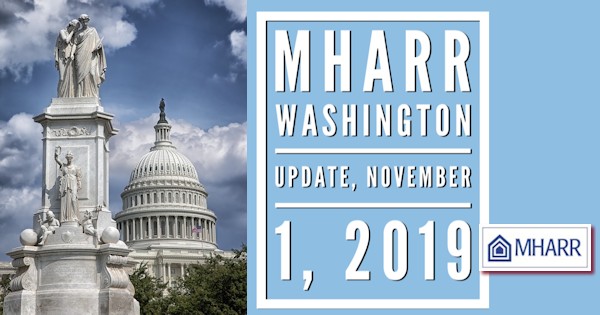
The need for affordable housing is not new. It was evident in the post-World War II boom that fueled the rise of mobile homes. While many mobile homes were fine, built to standards such as those administered by UL (Underwriters Laboratories) or ANSI (American National Standards Institute), other mobile homes were more problematic. Those problematic units were what led to pressure to establish universal standards for all such factory-built housing. Those standards were passed in 1974, which became the HUD Code (U.S. Housing and Urban Development regulated) manufactured homes which mandated third-party inspected federal safety, energy and durability standards.
The HUD Code for manufactured homes became effective on June 15, 1976. So mobile homes were a precursor to manufactured homes, and the terminology is distinctive, meaningful, and should not be mixed or conflated.
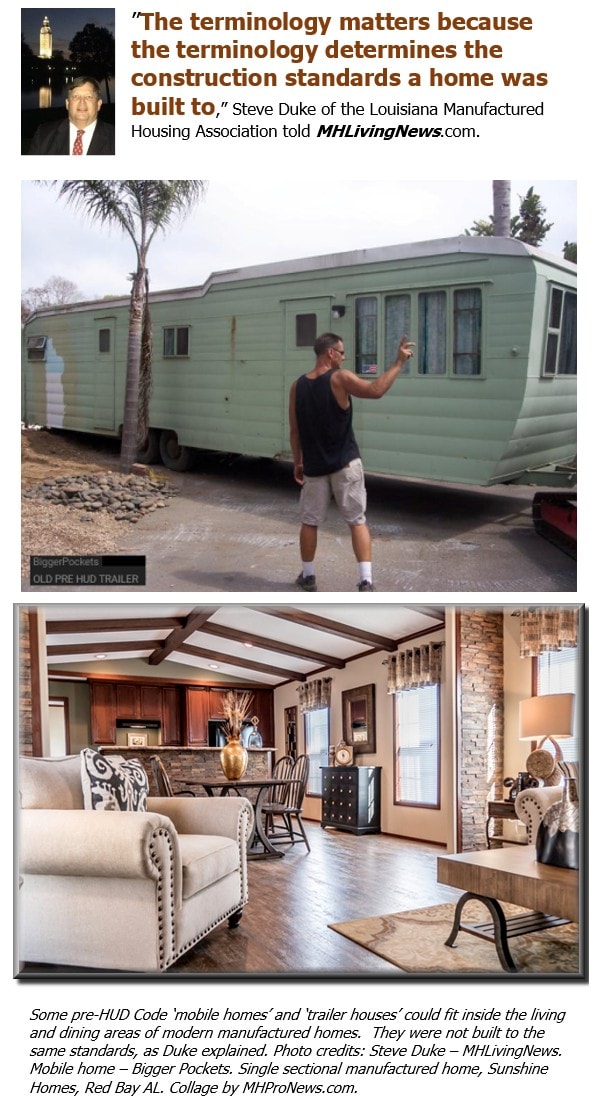
What follows in this report are a series of revealing or insightful comments made by people who have experienced and/or studied this specialized segment of the housing industry. Anyone who cares about:
- the rights of residents,
- renters aspiring to become homeowners,
- smaller independent businesses,
- ‘good job’ creation,
- sustainable economic development,
- greener and more sustainable construction,
- building wealth for lower income Americans,
- higher gross domestic product without increased debt,
- ethical investing with healthy returns,
- taxpayers and budgets,
- and other issues of broad interest, then this report will be a useful introduction or overview.
A historic snapshot is provided by CBS in the video below. Correspondent Mark Strassmann visited the Atocha manufactured home community in Santa Fe, NM. There CBS said the emphasis is on affordable housing; but it is contrasted with the Paradise Cove community in Malibu, Calif., where manufactured homes can cost a million dollars or more. Rephrased, millionaires live in manufactured homes, so do celebrities, as do a few billionaires. But the majority of this form of construction are enjoyed by people of more modest means. The realities defy several of the myths or misconceptions.
Note that the terminology in the video below is misused at times – see the proper definitions above and below – but the CBS overview is nevertheless useful.
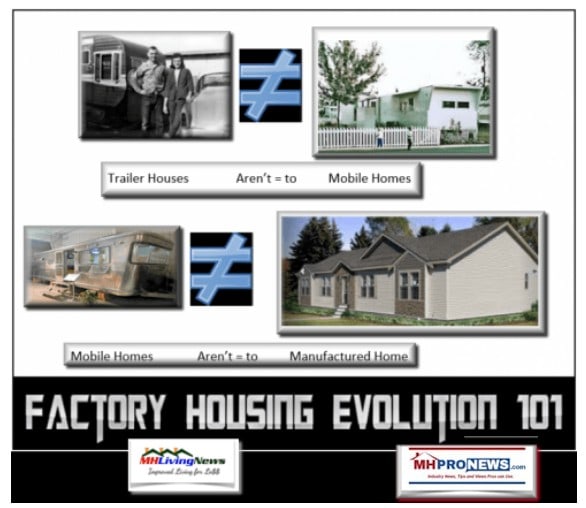
In 2000, now former President Bill Clinton signed the Manufactured Housing Improvement Act (MHIA), which passed with wide bipartisan support. With that backdrop, let’s dive into graphics and quotes that are near the core of today’s contemporary crisis in affordable housing.
Housing Researchers
The following quotes are from a 22-page report for the Fannie Mae Foundation in 2001 entitled “Why Advocates Need to Rethink Manufactured Housing.” That report by Richard Genz is linked here as a download. The quotes shown may not be in their original sequence but originate from that report. New readers should note that MHProNews sometimes shows quotes in ‘brown and bold text’ to make it distinctive or pop, but is otherwise as in the original. Following the pull quotes is Genz’s LinkedIn profile for added professional context.
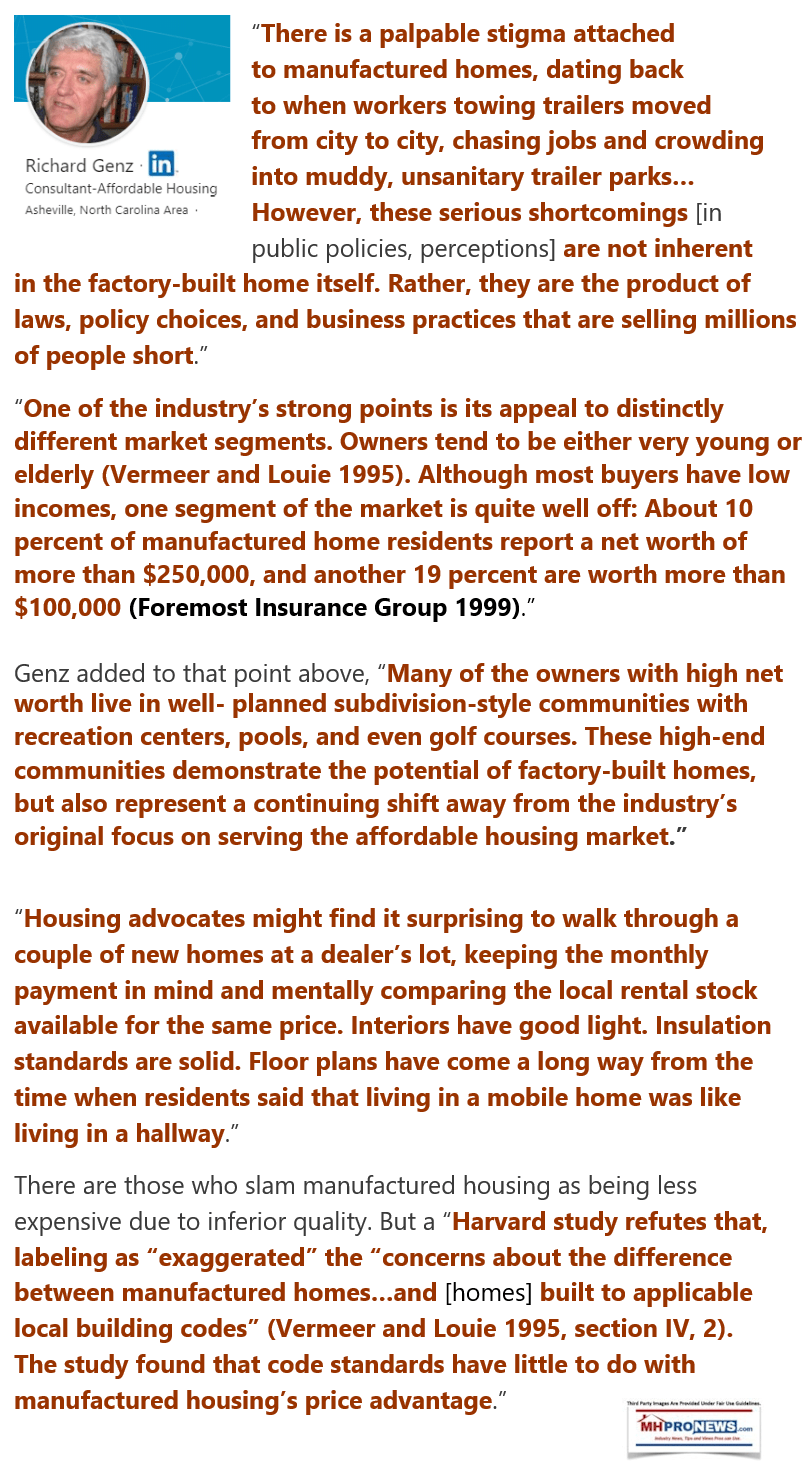
Here is Genz’s LinkedIn profile.

Next, let’s ponder two of numerous possible pull quotes from Eric Belsky, then with the Harvard Joint Center for Housing Studies (JCHS). Belsky was a contemporary of Genz, and both had access to the same research.

Belksy’s research was once touted by the Manufactured Housing Institute (MHI) in their promotional materials. But that was prior to Berkshire Hathaway’s acquisition of Clayton Homes, Oakwood Homes, and their associated lenders Vanderbilt Mortgage and Finance (VMF) and 21st Mortgage Corporation. Warren Buffett led Berkshire began that acquisition process in 2003, but their footprint in the industry has grown since, as will be outlined further below. Sometime after that, Belsky’s name disappeared from MHI’s touted lexicon. The same is true of Richard Genz, as the screen captures below reflect.

Next, let’s note that the above are just two of many published reports by third parties that for more than 2 decades reflected the proven quality, durability, energy savings, and consumer safeguards found in HUD Code manufactured homes. This is particularly true since the passage of the MHIA of 2000. So, why are these useful reports often missing from MHI’s website, as are the others noted above? A snapshot of just some of those positive research reports are found in the research anthology linked below. The pull quotes shown above and below the ‘ultimate‘ collection are from just 2 of several such reports found below.
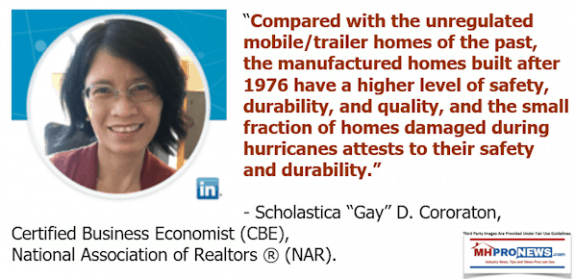
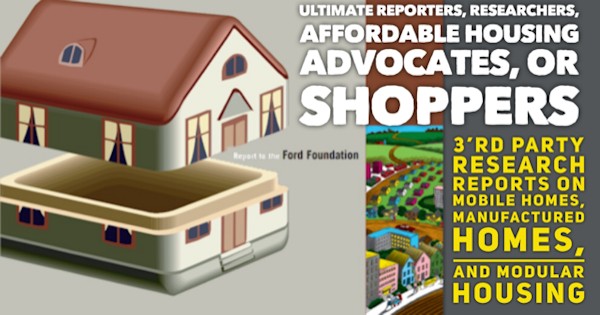

All of that research and more begs the puzzling question: why aren’t MHI, Clayton Homes, or other ‘big boys’ in the industry actively, loudly and proudly promoting such positive studies during an affordable housing crisis? Why have the powers that be in manufactured housing allowed the industry to struggle when there is so much evidence that could be put forth by academics and others to prove manufactured housing’s proven value?
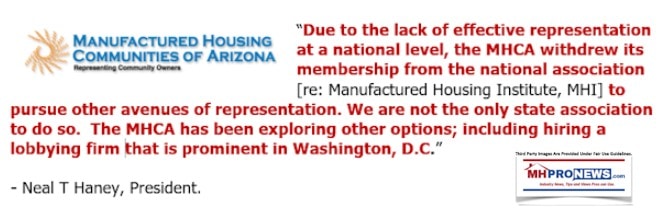
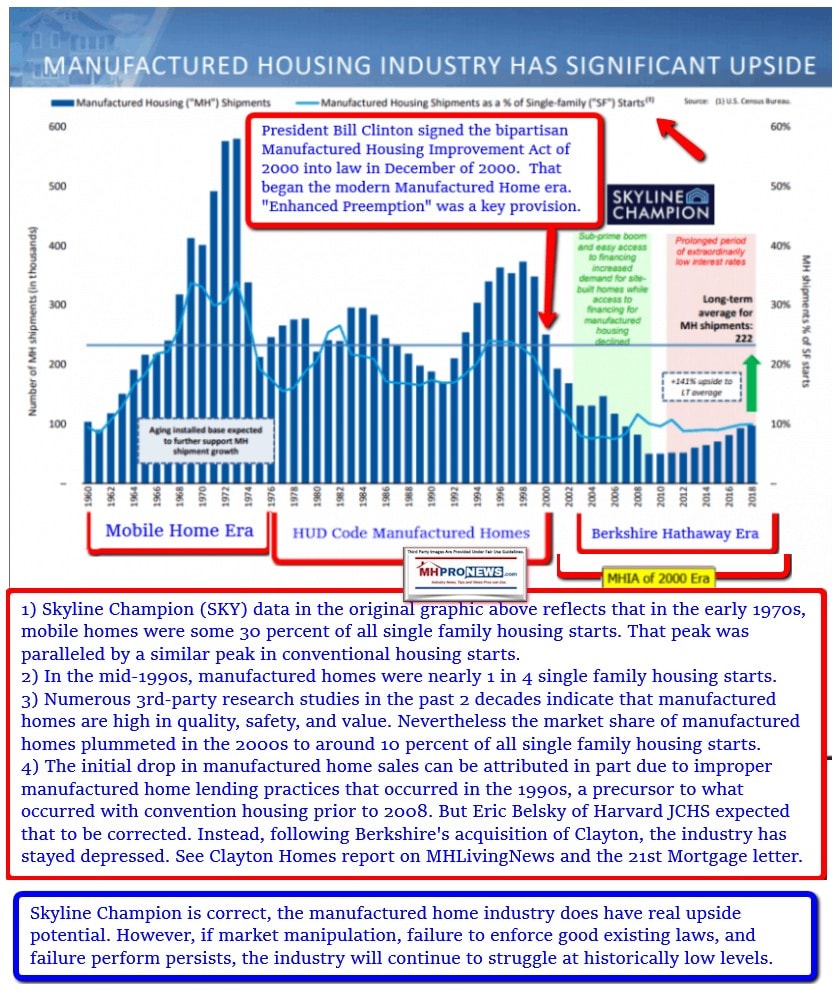
With that interesting, odd, and vexing backdrop, the in-depth report with documents, quotes in contexts and references are linked below. Ponder how this Samuel Clemens, a.k.a. Mark Twain quote may apply.

The “Bridging Gaps” report linked from the text and/or image box below comes into focus in the context of the positive reports linked above.
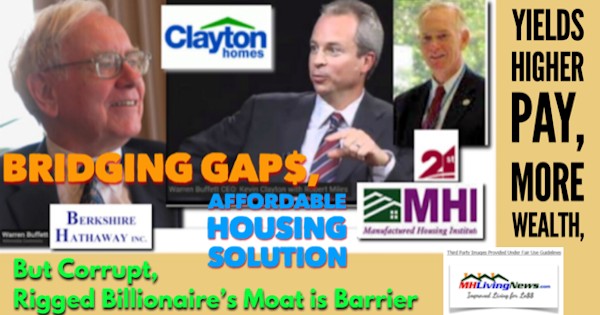
From that “Bridging Gaps” report, we see the video interview below of Clayton Homes President and CEO, Kevin Clayton. The original video of Clayton is a friendly ‘softball’ interview by a Berkshire Hathaway fan who has done more like it. So the statements made by Kevin are in some respects more revealing than say a deposition in a legal proceedings might produce. The original video appears to be a ‘recruitment’ or promotional tool for companies that may be considering selling out to Berkshire. Some of Kevin Clayton’s statements are straightforward, while some of it is arguably spin. An industry expert is thus useful in discerning those nuances, but the on screen anotation by MHProNews will help.
For example:
- Kevin says on camera that it would be okay with “Warren” Buffett if Clayton Homes lost money for five years, so long as the Berkshire owned manufactured housing company ‘was widening and deepening‘ their ‘competitive moat.’ That should be considered as a red-flag to antitrust and other investigators. One can make the case that they’ve done several of the things that Kevin claimed in that video. It is an important exhibit.
- Kevin also speaks about how Berkshire uses nonprofits, something Kevin Clayton is seemingly motivated by during that video. With that insight in mind, it is worth noting that donations from Buffett have flowed from various nonprofits to organizations like MHAction. MHAction in turn has used research done in conjuction with others that makes the industry appear predatory in reports like those spotlighted by HBO’s Last Week Tonight with John Oliver.
Prosperity Now, Nonprofits Sustain John Oliver’s “Mobile Homes” Video in Their Reports
- What the John Oliver video referenced in the report above doesn’t state is that every firm shown or named in that video appears to be a member of and/or connected to the Manufactured Housing Institute (MHI). That’s a signficant fact. For more on that see the John Oliver/MHAction white paper report linked here.
The version of the Kevin Clayton video below – posted near the end of the in depth report found here – is annotated with notes by MHProNews to set context and contrast with facts-claimed but is otherwise unaltered. Nothing that Kevin or his interviewer said was edited out or otherwise changed.
In 2017 documents were provided as news tips to MHProNews that led to our first “Smoking Gun” reports late that year. The documents were letters from Berkshire Hathaway owned 21st Mortgage Corporation (21st). 21st services independent retailers, while Vanderbilt Mortgage and Finance (VMF) provides lending to Clayton Homes owned company stores. The first of those 2 letters – signed by Tim Williams, president and CEO of 21st, is found below. As this is read, realize that it was in the wake of the 2008 housing/financial crisis. It sounds plausible, but is arguably paltering.
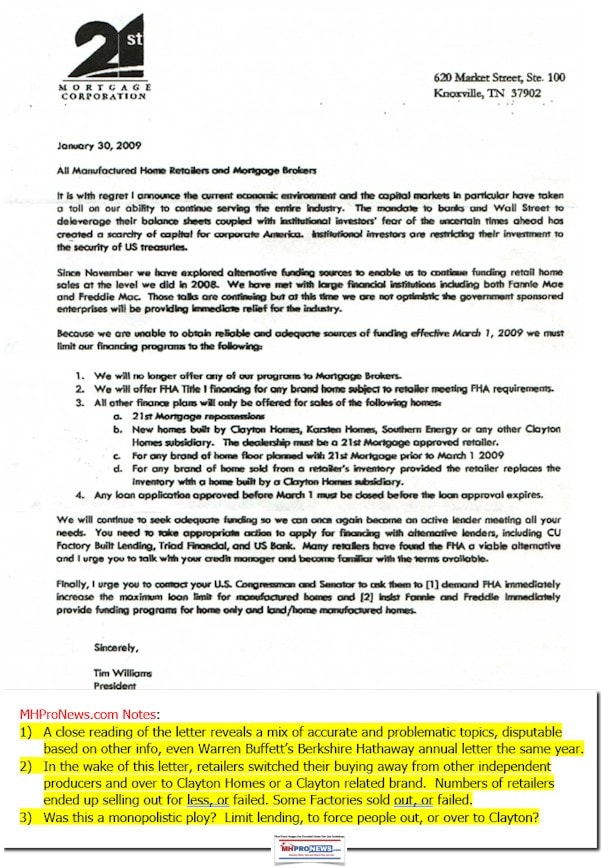
What impact did the throttling of credit have on the manufactured housing industry and its independents? Let’s see what the evidence reflects.
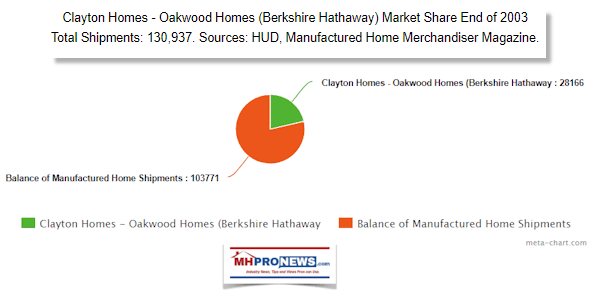
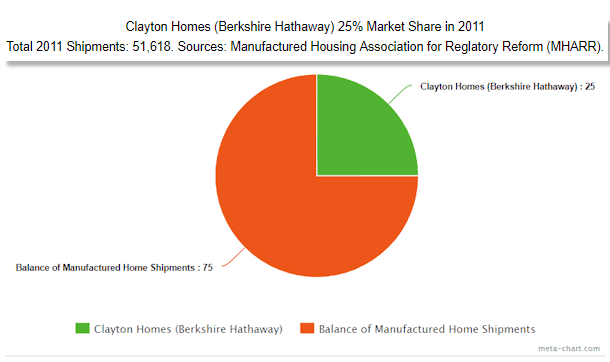
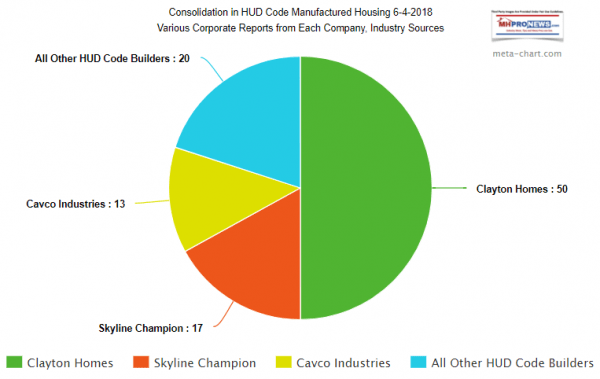

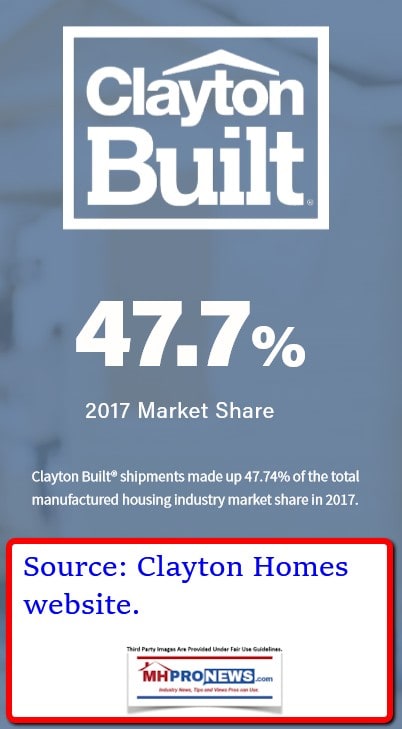

But instead of clarity and accuracy in those production figures, there are clear examples of conflicting claims issued by publicly traded firms, as well as by Clayton Homes, which is a wholly owned subsidiary of publicly traded Berkshire Hathaway.
As the report linked here points out, Warren Buffett himself has made statements to Berkshire shareholders that are demonstrably inaccurate when it comes to manufactured homes. Are those accidental misstatements? Or do such errors possibly have another purpose – say to elude regulatory scrutiny? Are these issues that merit SEC, FTC, DOJ, FHFA, and other investigations?
Hold those questions in mind, because some federal lawmakers have already asked for certain investigations.
A recent example of market share data using third-party collected and published information is found in the report linked above. That party – Statistical Surveys – has been collecting data on manufactured homes, RVs, and other industries for decades. They have no apparent ulterior motivation to do anything other than report information accurately.
Based upon Statistical Survey’s information, we see the following.

Compare and contrast Statistical Surveys data that with what Skyline Champion (SKY) recently reported to their shareholders, linked here and summarized in the screen capture with notes below.

Legal minds, investors, and objective thinkers can grasp the significance of publishing – arguably knowingly, since these are HUD Code manufactured home units whose labels are tracked – inaccurate and perhaps intentionally deceptive information. Cavco’s (CVCO) recent public filings indicate that the firm has spent millions of dollars in defending against claims and risks created by Joe Stegmayer’s purported breach of SEC directives and guidance. See that research of their public statements in the report linked below.
What may be hard to grasp for objective minds is this. Once the SEC subpoenas were made public, Stegmayer stepped down from his role at Cavco as that companies chairman, president, and CEO. But oddly, he kept on as the Manufactured Housing Institute (MHI) Chairman, filling out his full term. One might think that a trade association would want the same level of credibility and concern evidenced by a publicly traded company? But a close look at MHI’s leadership reveals that several MHI executive committee members represent companies that have a problematic history of legal and other reported scandals. It should be noted that Stegmayer is a former division president for Clayton Homes.
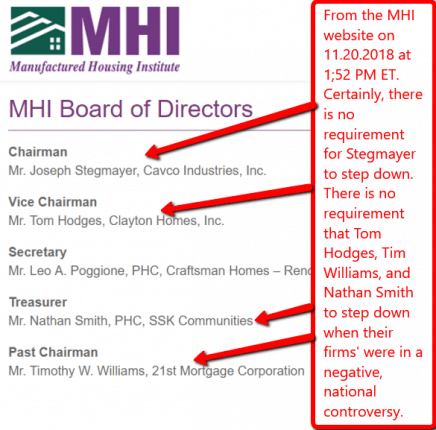
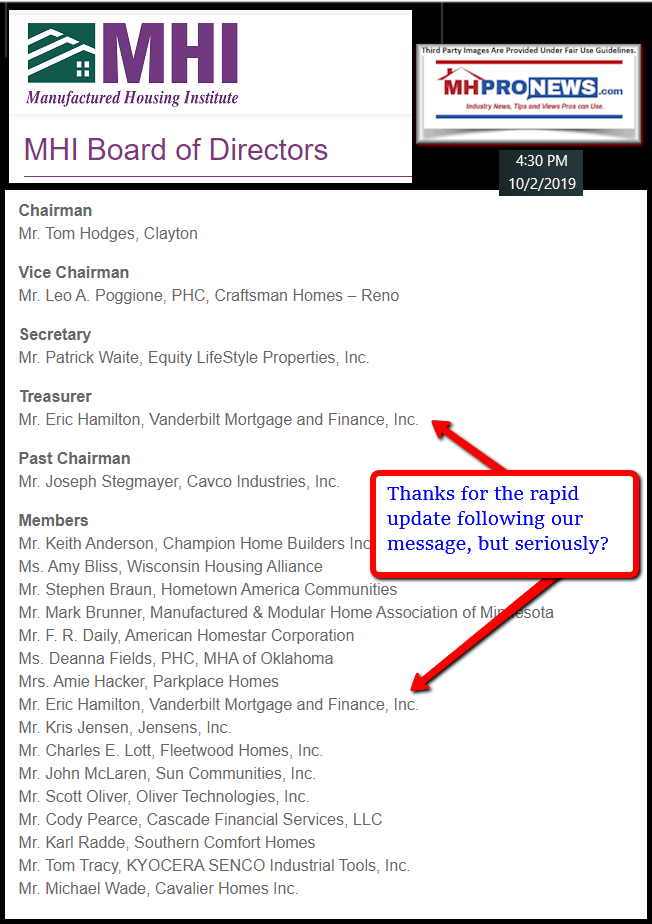
Good laws, Good Information, Repeated Failures to Use Them — Why?
Manufactured housing has the benefit of good laws passed by Congress in a widely bipartisan fashion. One was enacted during the Clinton Administration, the other in the Bush (43) Administration. But MHI and their ‘big boy’ members failure to perform seemingly self-evident promotion or the robust use of those laws. Those good laws are the Manufactured Housing Improvement Act (MHIA) of 2000, plus the Housing and Economic Recovery Act (HERA) of 2008.
- HERA’s Duty to Serve (DTS) provision should make lending securitized by Fannie Mae and Freddie Mac widely available at lower interest rates than loans originated by Berkshire Hathaway brands. A decade after passage, it is still not being properly enforced, as a recent Minneapolis Federal Reserve and Senator Tina Smith’s (MN-D) letter to her colleagues explained. Both of those linked items make it clear that there is a disproportionate harm done to lower income and minorities, some of the very groups HERA sought to serve via DTS to manufactured housing.

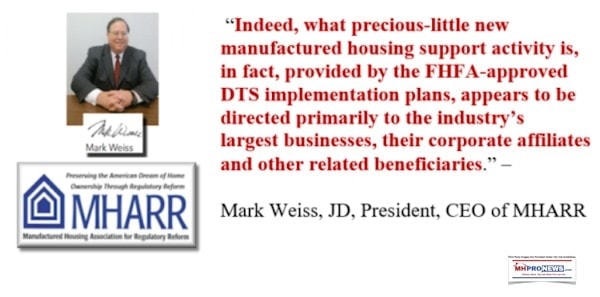
- The MHIA includes the “enhanced preemption” provision of the law that would make it easy to place a HUD Code manufactured home into rural as well as municipal areas, because local zoning would not be able to override it. Why that law is significant is shown below.
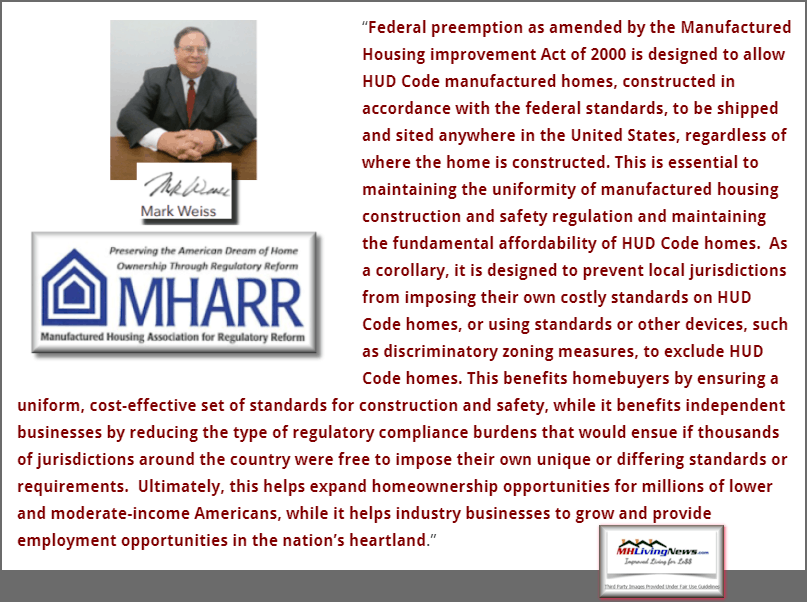
After years of hammering away at MHI for their failure to properly promote – or in many cases even mention – enhanced preemption in published reports or their own website, last summer, MHI finally relented and issued a letter that included the following.

But even since that statement was obtained from MHI, acknowledging what should be obvious to them as professionals, they have repeatedly failed to push for or often even mention enforcement of that important law. Perhaps more important, they have not used several face-to-face opportunities to raise the issue of enhanced preemption with top HUD officials. Why not? The report linked below sheds additional light on this, in part through the comments by William ‘Bill’ Matchneer, J.D., who served at HUD, the CFPB, and whose firm does work for MHI.
There is more, as the reports linked further below make clear. But this snapshot of decades of research and evidence of how good laws are being thwarted makes a compelling case for this. That while the industry is arguably artificially underperforming, a few larger firms who are often members of MHI are consolidation production, retail, and land-lease communities. Doesn’t that bear regulatory and legal investigations?
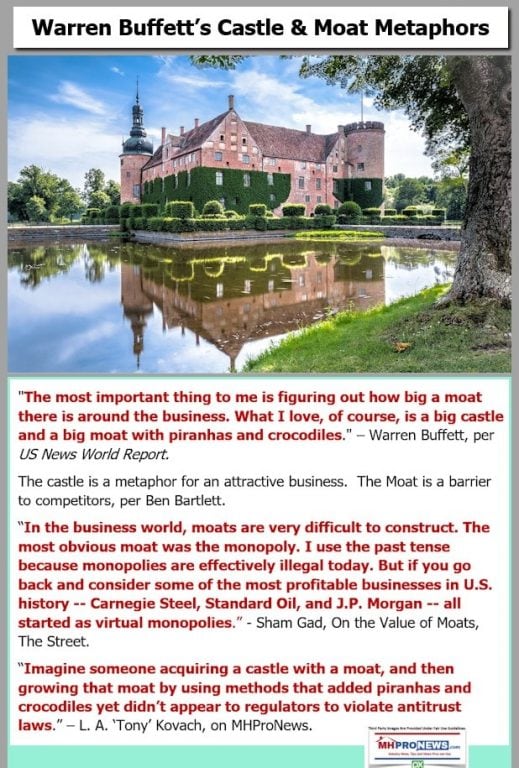
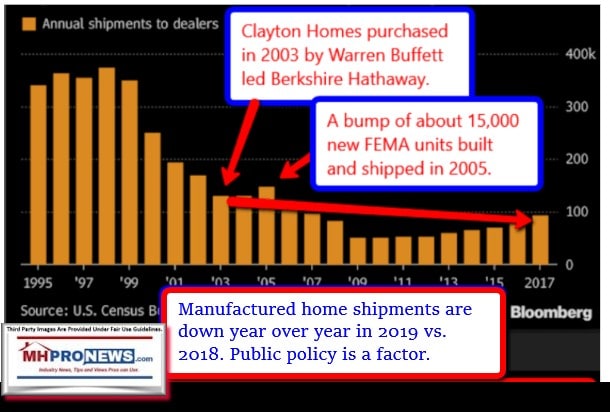
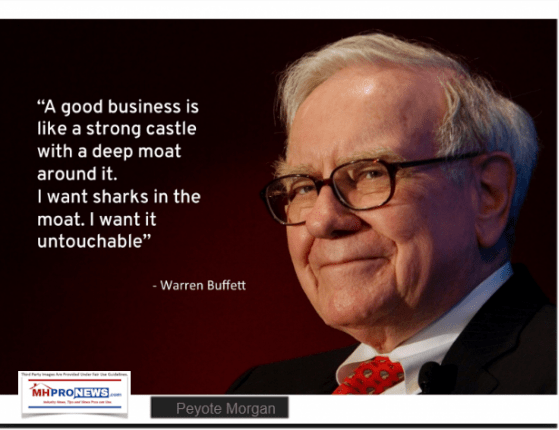
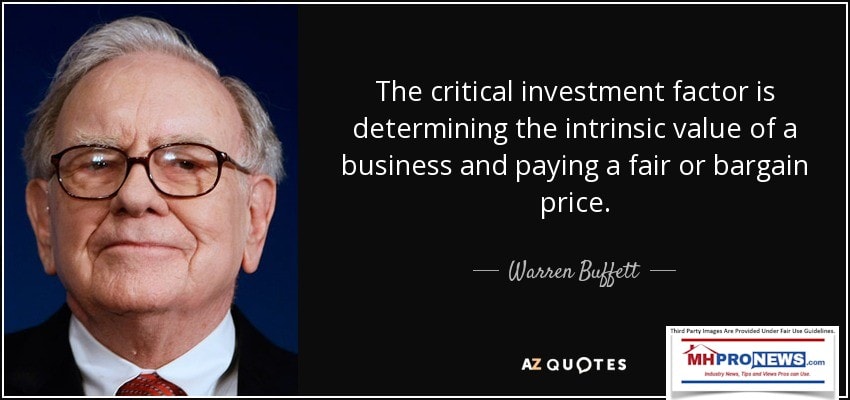
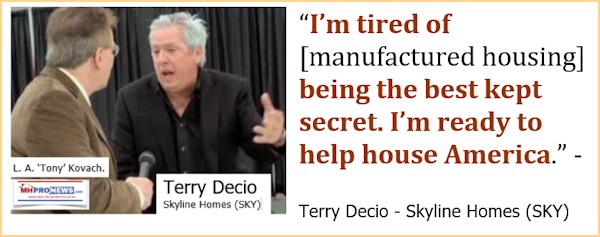
The truth is hiding in plain sight in the form of good laws, good research, and publicly available information. But to a degree it requires some expertise to spot the purported cons involved. In principle, that is not very different than what occurred with con-artist Bernie Madoff. Millions of Americans are being harmed by this ploy, as are taxpayers. The lack of affordable housing in turn hurts the broader economy, as the report below documents.

The reason that Scholastica ‘Gay’ Cororaton did her research on manufactured housing is because Lawrence Yun, Ph.D., Chief Economist of the National Association of Realtors asked her to do it. Yun has previously said that the only solution to the affordable housing crisis is for builders to get really busy.
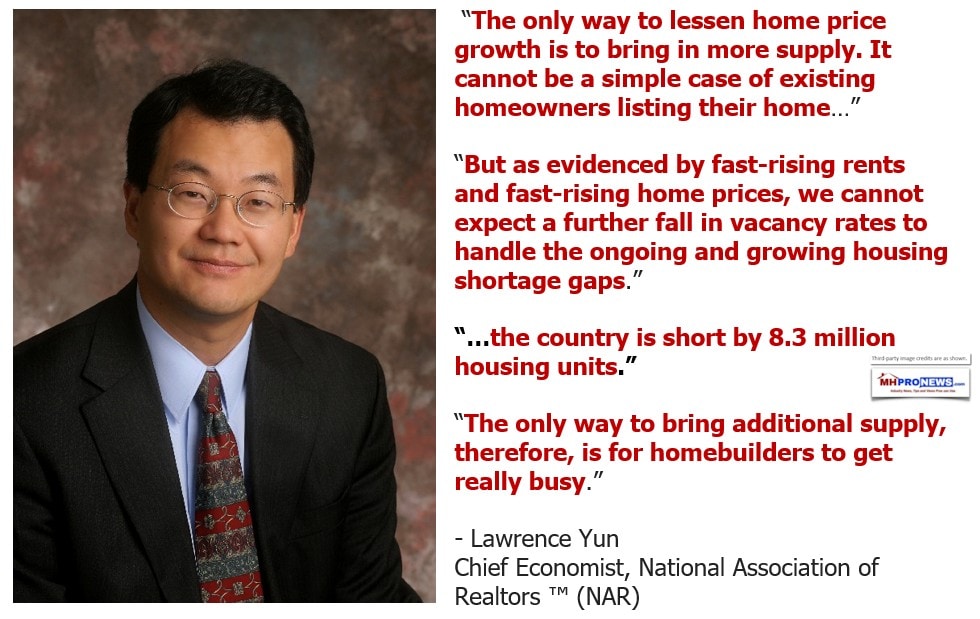
But conventional builders can’t keep up with demand, nor can they hit the price points needed by lower income Americans. Yun and others, including tech giants, have reasoned that factory-building is necessary. The most proven form of factory building is HUD Code manufactured homes.
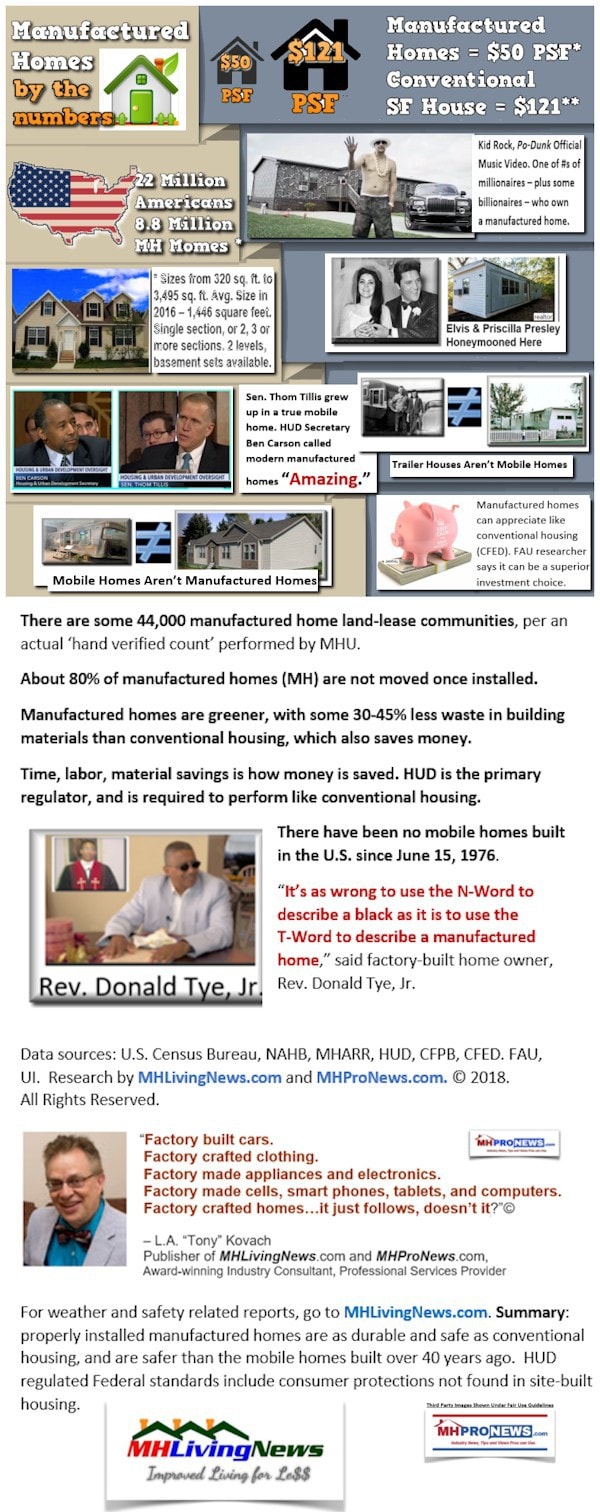

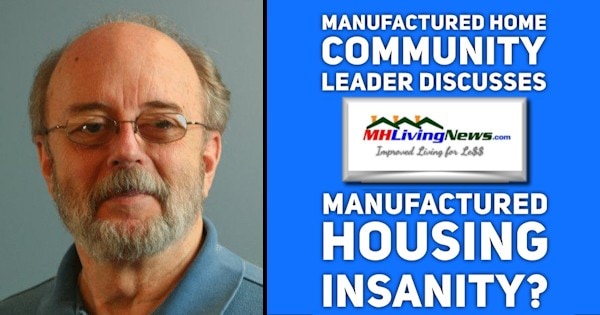
There is much more, as the linked reports above, below and following the byline reflect.
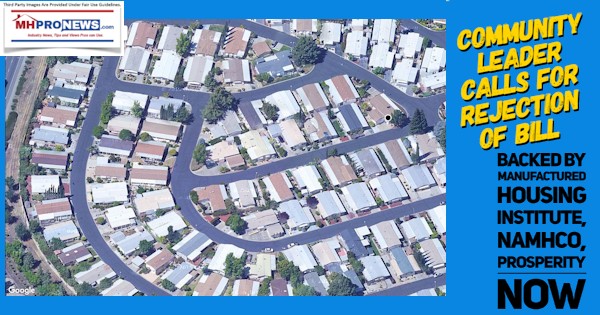
Summary
To sum up,
- there are decades of positive reports about manufactured homes. That good research isn’t being promoted by MHI, though at one time before the Berkshire era, it was.
- There are good laws on the books that were placed there so that more affordable housing could be made available to more Americans. Yet those laws are oddly going un-enforced or under-enforced. Several institutions within manufactured housing – MHI for example – appears to be either hopelessly inept at using good laws and good information, and/or is deliberately mishandling such laws and positive information.
- That has the net result of smaller firms often succumbing to what may at first blush seem to be ‘market forces,’ but upon closer examination fit the pattern described by Kevin Clayton in the video above regarding the Buffett strategic Moat.
- There are reasons to believe that failure to enforce those good existing laws involves some level of collusion between public officials, Fannie Mae, Freddie Mac, MHI, and various Berkshire brands, among others.
- Delayed gratification by the ‘big boys’ who dominate manufactured housing means they could make more money later, lots of it. In the case of Berkshire, they have interests in conventional housing, rentals, and manufactured homes. They can afford to toy with the problem of affordable housing, while millions of Americans are paying the price.
Treachery is hardly new. America had its Benedict Arnold. Cicero wrote about the dangers of the unscrupulous ambitious and turncoats. Why is it hard to image that there is a relatively small group of professionals – with MHI as a nexus – are working with each other to consolidate the industry at a discounted valuation? All the while it may appear to casual observers to be ‘market forces,’ so that Berkshire or others don’t get hit with antitrust violations. The numbers of top executives needed for such a collusion are relatively small, because MHI and others will simply follow instructions.

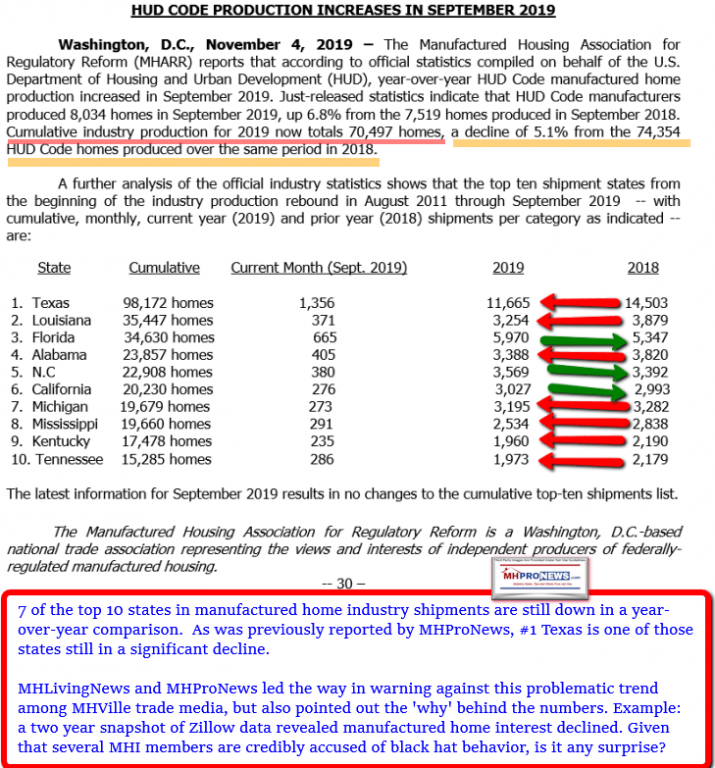
If it looks like a rat, smells like one, chances are – its a rat. That’s your first installment today of manufactured housing “Industry News, Tips, and Views Pros Can Use,” © your runaway biggest and most-read professional information resource, where “We Provide, You Decide.” © (News, fact-checks, analysis, and commentary.)

Soheyla is a co-founder and managing member of LifeStyle Factory Homes, LLC, the parent company to MHProNews, and MHLivingNews.com. Connect with us on LinkedIn here and here.
Related Reports:
Click the image/text box below to access relevant, related information.
Publicly Traded Manufactured Housing Firms – Which Source Do You Trust More? Why? MHI, MHARR, Others
Unique Opportunities for More Competitive Lending for All HUD Code Manufactured Homes
